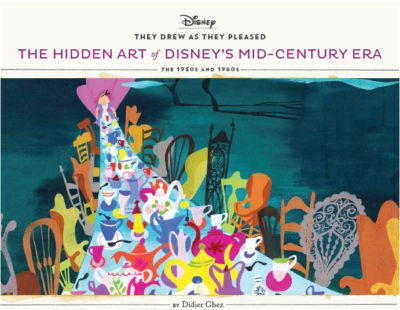 They Drew as they Pleased is a six-part book series by Disney Historian Didier Ghez chronicling the unsung heroes of Disney Animation and artwork that has rarely been seen outside of the studio and the private collectors who now own it. In the fourth installment, Disney fans will get an intimate portrait into the lives of six talented artists, several of which are household names in the Disney fan community while the majority are largely unknown. They Drew As They Pleased Vol. 4: The Hidden Art of Disney’s Mid-Century Era (The 1950’s and 1960’s) explores some of the most magical and iconic years at The Walt Disney Studio.
They Drew as they Pleased is a six-part book series by Disney Historian Didier Ghez chronicling the unsung heroes of Disney Animation and artwork that has rarely been seen outside of the studio and the private collectors who now own it. In the fourth installment, Disney fans will get an intimate portrait into the lives of six talented artists, several of which are household names in the Disney fan community while the majority are largely unknown. They Drew As They Pleased Vol. 4: The Hidden Art of Disney’s Mid-Century Era (The 1950’s and 1960’s) explores some of the most magical and iconic years at The Walt Disney Studio.
In his preface, Ghez explains that he never intended to add Mary Blaire to the series since her work is so well known. But when he discovered enough unpublished pieces of art from her Disney years, he couldn’t resist. She is joined by her husband, Lee Blair, in addition to Tom Oreb, John Dunn, and Walt Peregoy. Peregoy is infamous for his mid-century background designs for One Hundred and One Dalmatians, a style that Walt Disney famously disliked.
With a focus on the mid-century, fans will be treated to artwork from the classic films of that era like Cinderella, Alice in Wonderland, Peter Pan, Lady and the Tramp, Sleeping Beauty, One Hundred and One Dalmatians, The Sword in the Stone, and The Jungle Book. This also includes work that the studio did for television, including the Hurrell Productions tv commercials, the Man in Space series, and The Mickey Mouse Club. But since many of these artists got their start prior to the mid-century, artwork from as early as the 1930’s to as late as the 1980’s is included from some of these talented artists.
The biggest thrill of this series for me is the artwork from abandoned projects, and fans will find more of them here. Artwork is collected from unproduced shorts like The Barefoot Boy, One More Spring, The History of Transportation, Abdul Abulbul Amir, and Bad Luck Duck. Unmade features like Don Quixote, Chanticleer, and Catfish Bend also get some time to shine. Alice in Wonderland fans will delight in the artwork here from the deleted “Jabberwocky” sequence. Another rare gem is Mary Blaire’s take on Winnie the Pooh from the 1940’s.
This volume contains a forward by Eric Goldberg and Susan McKinsey Goldberg. It’s especially fitting since Eric’s sequence from Fantasia 2000 was inspired by Al Hischfeld, whose style had a seemingly large impact on mid-century design. His animation on Genie also harkens back to the styles established in this era.
In my review of volume 3, I mentioned that this series makes a great gift for Disney Animation fans. However, I would go a step further and state that this series is a required part of any Disney Animation fan’s library. Most exciting of all, the next volumes will take readers into less-traveled territory, the 1970’s through 1990’s. There’s never been a series on Disney Animation that has spanned this length of time and revealed so many hidden artists behind these classic films.
